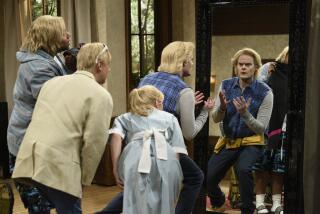Big bunch of phonies
- Share via
Want a glimpse of the freakish future that awaits if cloning isn’t outlawed? Then swing by the Hollywood Roosevelt Hotel tonight for the 14th annual Reel Awards.
There, you’ll encounter the true promise of human duplication experiments. No, not a room full of Mother Teresas and Albert Einsteins. Instead, the place will be crawling with carbon copies of Michael Jackson, Joan Rivers, Saddam Hussein and Cher.
The Reel Awards, a semi-spoof of the Oscars, are designed to honor the nation’s best celebrity impersonators.
It’s a burgeoning field. With top acts earning thousands of dollars per appearance, imitation is now a multimillion-dollar form of flattery. And the industry seems to be expanding at a disturbing pace.
When Elvis Presley left the planet in 1977, only a few dozen people were mimicking him. By 1999, the ranks of pseudo-Elvii had bloated to 35,000, according to news reports. Statisticians jokingly warned that if the growth rate continued, one out of every three humans would be an Elvis impersonator by the year 2019.
Sadly, nobody knows the current number of Elvis imitators. After the Sept. 11 attacks, government officials turned their attention to “more important” threats to world stability.
So, here we are, 14 years from a possible Elvis apocalypse and no one is doing anything. Even if the Presley plague is somehow contained, other dangers loom:
* The number of Abraham Lincoln impersonators has also exploded, from one in 1885 to 40 in 1990 to nearly 200 today, according to the Assn. of Lincoln Presenters. Ominously, there are no John Wilkes Booth impersonators to keep the Lincoln population in check.
* A New York Times investigation uncovered the existence of 150 ABBA tribute bands in Britain alone.
* Some faux celebrities might be procreating. Last July, the Wall Street Journal chronicled the wedding of an Arnold Schwarzenegger look-alike to a Shania Twain double. They met at an impersonators convention.
* Janis Joplin’s estate just announced plans for a reality TV show and concert tour in which contestants try to resurrect the singer’s persona.
What’s more, an Encino talent agency’s client roster now includes an impersonator of Rich Little. In other words, an impersonator of an impersonator.
OK, we made up that last item, but the others are true. The only bright spot on the horizon is Iraq, which seemingly experienced a net loss of Saddam Hussein doubles after the U.S.-led invasion.
Everywhere else, fueled by the public’s obsession with celebrities, the line between reality and fakery grows increasingly blurred.
The classic example is Tim Owens of Ohio, who spent years in a Judas Priest tribute band, impersonating lead singer Rob Halford. After the real Halford quit, the group hired Owens as his replacement.
Blame it on the Bible. In the Book of Genesis, Jacob pioneered celebrity impersonations with a primitive Sensurround imitation of his older brother, Esau. To trick his blind father into giving him a blessing intended for Esau, Jacob duplicated his brother’s hairiness by wearing goat fur -- and his sibling’s body odor by donning Esau’s smelly clothes.
Despite Jacob’s groundbreaking work, Reel Awards founders Alana and Janna Joos say the mimic market didn’t catch on until the 1970s, with the rise of singing telegrams performed by fake Elvises and Marilyn Monroes.
Another boost was “Beatlemania,” the Broadway stage show that premiered in 1977. But the big turning point came six years later. John Stuart, a onetime producer of Mormon devotional films, created “Legends in Concert,” a Las Vegas tribute show starring doppelgangers of such dead pop icons as Buddy Holly, John Lennon and Joplin. Like a virus, the concept quickly spread around the globe and spawned numerous copycats.
Today, it seems as if every famous person -- dead or alive, fictional or real -- has at least one professional impostor. The Joos sisters’ 1,500-person roster (www.internationalcelebrityimages.com) runs the gamut from Beethoven to Boris Yeltsin, Kato Kaelin to k.d. lang, Gomez Addams to Granny Clampett, Phil Jackson to Freud.
Many impersonators go to extreme lengths to create authenticity. In addition to expensive costumes and prosthetic teeth made from molds of the real star’s mouth (a major advance over Jacob’s goatskins), some undergo liposuction or plastic surgery.
Alana Joos figures the demand for look-alikes will continue to grow. Indian tribes keep opening new casinos and “they all need shows,” she says.
Corporate shindigs are another gold mine. Many companies can’t afford the real McCoys, so they hire reasonable facsimiles. The public doesn’t seem to mind. “Any time people can get close to a celebrity, even if it’s just an impersonator, they get excited,” Joos says.
Which brings us back to the Reel Awards. Janna Joos says seeing multiple Jack Nicholsons and Madonnas in the same room is a bit surreal -- “like looking at a mirror in a mirror.”
That’s one interpretation. Another is this: It’s a warning to all mankind! If cloning is legalized, we’ll see this scene times a thousand. Or a million.
Moreover, the clones will probably mutate into bizarre life forms. It’s already happening among impersonators. The Elvis community is splintering into such swivel-hips subspecies as flying Elvises, Mexican Elvises (El Vez), Jewish Elvises (Melvis), Swedish Elvises and Christian evangelist Elvises (one gospel Presley told a Christian magazine, “I’m the only Jesus some people will ever see”).
There are red state Kings and blue-suede state Kings. There’s even a “green Elvis” who sings environmentally conscious tunes. “In the Ghetto” becomes “In the Landfill,” and “Are You Lonesome Tonight?” converts to “Are You Recycling Tonight?”
How can this insanity be stopped? We believe the most effective anti-cloning argument requires just three words:
“Multiple Donald Trumps.”
*
Roy Rivenburg can be reached at roy.rivenburg@latimes.com
More to Read
The biggest entertainment stories
Get our big stories about Hollywood, film, television, music, arts, culture and more right in your inbox as soon as they publish.
You may occasionally receive promotional content from the Los Angeles Times.










